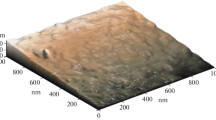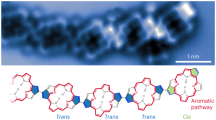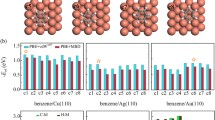Abstract
To clarify the effect of covalent surface adsorption on the geometric and electronic structure of carboranes, p-carboranethiol (pCT) was deposited on clean Au(111) surfaces under vacuum and the resulting systems were probed by scanning tunneling microscopy, scanning tunneling spectroscopy and ultraviolet photoelectron spectroscopy. The spectral features observed at different pCT coverage levels revealed the emergence of new electronic states near the surface, which were analyzed using ab initio calculations. The resulting computational and experimental data are used to explain the contributions of these states to bonding between the substrate and adsorbate, resonance with metallic substrate states and substrate-mediated intermolecular interactions.









Similar content being viewed by others
References
Di CA, Zhang FJ, Zhu DB (2013) Multi-functional integration of organic field-effect transistors (OFETs): advances and perspectives. Adv Mater 25:313–330
Kroto HW, Heath JR, O’Brien SC, Curl RF, Smalley RE (1985) C60: buckminsterfullerene. Nature 318:162–163
Reed CA (2005) Carborane acids. New ‘‘strong yet gentle’’ acids for organic and inorganic chemistry. Chem Commun 36:1669–1677
Tan C, James R, Dong B, Driver MS, Kelber JA, Downing G, Cao LR (2015) Characterization of a boron carbide-based polymer neutron sensor. Nucl Instrum Methods Phys Res A803:82–88
Pasquale FL, Li Y, Du J, Kelber JA (2013) Novel alloy polymers formed from ortho-carborane and benzene or pyridine. J Phys Condens Matter 25:105801–105808
Patel M, Swain AC, Cunningham JL, Maxwell RS, Chinn SC (2006) The stability of poly(m-carborane-siloxane) elastomers exposed to heat and gamma radiation. Polym Degrad Stab 91:548–554
Perkinsa FK, Rosenberg RA, Lee S, Dowben PA (1991) Synchrotron-radiation-induced deposition of boron and boron carbide films from boranes and carboranes: decaborane. J Appl Phys 69:4103–4109
McIlroy DN, Zhang J, Dowben PA, Heskett D (1996) Band gaps of doped and undoped films of molecular icosahedra. Mater Sci Eng A 217(218):64–68
Caruso AN, Bernard L, Xu B, Dowben PA (2003) Comparison of adsorbed orthocarborane and metacarborane on metal surfaces. J Phys Chem B 107:9620–9623
Januszko A, Glab KL, Kaszynski P, Patel K, Lewis RA, Mehl GH, Wand MD (2006) The effect of carborane, bicyclo[2.2.2]octane and benzene on mesogenic and dielectric properties of laterally fluorinated three-ring mesogens. J Mater Chem 16:3183–3192
Schwartz JJ, Mendoza AM, Wattanatorn N, Zhao Y, Nguyen VT, Spokoyny AM, Mirkin CA, Baše T, Weiss PS (2016) Surface dipole control of liquid crystal alignment. J Am Chem Soc 138:5957–5967
Grzelczak MP, Danks SP, Klipp RC, Belic D, Zaulet A, Kunstmann-Olsen C, Bradley DF, Tsukuda T, Viñas C, Teixidor F, Abramson JJ, Brust M (2017) Ion transport across biological membranes by carborane-capped gold nanoparticles. ACS Nano 11:12492–12499
Huang R, Liu K, Liu H, Wang G, Liu T, Miao R, Peng H, Fang Y (2018) Film-based fluorescent sensor for monitoring ethanol–water-mixture composition via vapor sampling. Anal Chem 90:14088–14093
Ni H, Qiu Z, Xie Z (2017) Photoarylation of iodocarboranes with unactivated (hetero)arenes: facile synthesis of 1,2-[(hetero)aryl]n-o-carboranes (n = 1,2) and o-carborane-fused cyclics. Angew Chem Int Ed 56:712–716
Otsuka M, Takita R, Kanazawa T, Miyamoto K, Muranaka A, Uchiyama M (2015) Conjugation between σ- and π-aromaticity in 1-C-arylated monocarba-closo-dodecaborate anions. J Am Chem Soc 137:15082–15085
Baše T, Bastl Z, Plzák Z, Grygar T, Plešek J, Carr MJ, Malina V, Šubrt J, Boháček J, Večerníková E, Kříž O (2005) Carboranethiol-modified gold surfaces. A study and comparison of modified cluster and flat surfaces. Langmuir 21:7776–7785
Thomas JC, Boldog I, Auluck HS, Bereciartua PJ, Dušek M, Macháček J, Bastl Z, Weiss PS, Baše T (2015) Self-assembled p-carborane analogue of p-mercaptobenzoic acid on Au{111}. Chem Mater 27:5425–5435
Ito M, Wei TX, Chen PL, Akiyama H, Matsumoto M, Tamadab K, Yamamoto Y (2005) A novel method for creation of free volume in a one-component self-assembled monolayer: dramatic size effect of para-carborane. J Mater Chem 15:478–483
Kang J, Rowntree PA (2007) Gold film surface preparation for self-assembled monolayer studies. Langmuir 23:509–516
Hohman JN, Zhang P, Morin EI, Han P, Kim M, Kurland AR, McClanahan PD, Balema VP, Weiss PS (2009) Self-assembly of carboranethiol isomers on Au{111}: intermolecular interactions determined by molecular dipole orientations. ACS Nano 3:527–536
Scholz F, Nothofer HG, Wessels JM, Nelles G, Wrochem FV, Roy S, Chen X, Michl J (2011) Permethylated 12-vertex p-carborane self-assembled monolayers. J Phys Chem C 115:22998–23007
Ulman A (1996) Formation and structure of self-assembled monolayers. Chem Rev 96:1533–1554
Balaz S, Caruso AN, Platt NP, Dimov DI, Boag NM, Brand JI, Losovyj YB, Dowben PA (2007) The influence of the molecular dipole on the electronic structure of isomeric icosahedral dicarbadodecaborane and phosphacarbadodecaborane molecular films. J Phys Chem B 111:7009–7016
Wrochem FV, Scholz F, Gao D, Nothofer HG, Yasuda A, Wessels JM, Roy S, Chen X, Michl J (2010) High-band-gap polycrystalline monolayers of a 12-vertex p-carborane on Au(111). J Phys Chem Lett 1:3471–3477
Plešek J, Heřmánek S (1981) Syntheses and properties of substituted icosahedral carborane thiols. Collect Czech Chem Commun 46:687–692
Barth JV, Brune H, Ertl G, Behm RJ (1990) Scanning tunneling microscopy observations on the reconstructed Au(111) surface: atomic structure, long-range superstructure, rotational domains, and surface defects. Phys Rev B 42:9307–9318
Narasimhan S, Vanderbilt D (1992) Elastic stress domains and the herringbone reconstruction on Au(111). Phys Rev Lett 69:1564–1567
Kevan SD, Gaylord RH (1987) High-resolution photoemission study of the electronic structure of the noble-metal (111) surfaces. Phys Rev B 36:5809–5818
Avouris P, Lyo IW, Walkup RE, Hasegawa Y (1994) Real space imaging of electron scattering phenomena at metal surfaces. J Vac Soc Technol B 12:1447–1455
http://www.gaussian.com/. Accessed 9 Apr 2019
https://www.vasp.at/. Accessed 9 Apr 2019
Shirai Y, Morin JF, Sasaki T, Guerreroa JM, Tour JM (2006) Recent progress on nanovehicles. Chem Soc Rev 35:1043–1055
Ohara M, Kim Y, Kawai M (2006) Tunneling-electron-induced hopping of methylthiolate on Cu(111). Jpn J Appl Phys 45:2022–2025
Momose T, Shudo K, Raebiger H, Ohno S, Kitajima T, Uchiyama M, Suzuki T, Tanaka M (2014) Molecular motion induced by multivibronic excitation on semiconductor surface. J Phys Chem C 118:1554–1559
Aoki M, Kamada T, Sasaki K, Masuda S, Morikawa Y (2012) Chemisorption-induced gap states at organic–metal interfaces: benzenethiol and benzeneselenol on metal surfaces. Phys Chem Chem Phys 14:4101–4108
Britton AJ, Rienzo A, O’Shea JN, Schulte K (2010) Charge transfer between the Au(111) surface and adsorbed C60: resonant photoemission and new core-hole decay channels. J Chem Phys 133:094705
Yun DJ, Shin WH, Bulliard X, Park JH, Kim S, Chung JG, Kim Y, Heo S, Kim SH (2016) Direct characterization of the energy level alignments and molecular components in an organic hetero-junction by integrated photoemission spectroscopy and reflection electron energy loss spectroscopy analysis. Nanotechnology 27:345704–345714
Acknowledgements
The project was financially supported by the Japan Society for the Promotion of Science, Grants-in-Aid for Scientific Research C (Kakenhi 16K04992). Some of the calculations presented here were performed using Hokusai and Sekirei: The supercomputer facilities of the Advanced Center for Computing and Communication, Riken, and the Institute for Solid State Physics, University of Tokyo, respectively. The authors gratefully acknowledge the assistance of Prof. Koichi Ohno (Current affiliation: Tohoku University, and the Institute for Quantum Chemical Exploration) with computation. In addition, K.S. wishes to express special thanks to Dr. Hideaki Muratake (Current affiliation: Katsura Chemical Co., Ltd.) for his assistance with chemical synthesis.
Author information
Authors and Affiliations
Corresponding author
Additional information
Publisher's Note
Springer Nature remains neutral with regard to jurisdictional claims in published maps and institutional affiliations.
Rights and permissions
About this article
Cite this article
Aoki, T., Nakahama, Y., Ikeda, T. et al. Electronic states of 3D aromatic molecules on Au(111) surfaces: adsorption of carboranethiol. J Mater Sci 54, 10249–10260 (2019). https://doi.org/10.1007/s10853-019-03598-2
Received:
Accepted:
Published:
Issue Date:
DOI: https://doi.org/10.1007/s10853-019-03598-2




